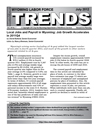
Wyoming Jobless Rate Falls to 5.2% in May 2012
The Research & Planning section of the Wyoming Department of Workforce Services has reported that the state's seasonally adjusted1 unemployment rate decreased from 5.3% in April to 5.2% in May. Wyoming's jobless rate was considerably lower than its May 2011 level of 6.0% and the current U.S. rate of 8.2%. Seasonally adjusted employment of Wyoming residents increased by 927 individuals (0.3%) from April to May.
From April to May, most county unemployment rates followed their normal seasonal pattern and decreased. Employment tends to increase in May, with warmer weather bringing seasonal job gains in leisure & hospitality, construction, government, retail trade, and professional & business services. The largest over-the-month unemployment rate decreases occurred in the northwest area of the state. Teton County's unemployment rate fell from 11.4% in April to 8.7% in May, Lincoln County's rate fell from 8.5% to 7.1%, and Park County's rate fell from 6.1% to 5.2%.
Teton County posted the highest unemployment rate in May (8.7%). The next highest rates were found in Lincoln (7.1%), Fremont (5.8%), and Laramie (5.7%) counties. The lowest jobless rates occurred in Sublette (3.2%), Campbell (3.9%), and Albany (4.0%) counties.
Compared to a year earlier, jobless rates fell in nearly all counties. Niobrara County was the exception, with unemployment unchanged from May 2011 (4.1%). The largest decreases were found in Lincoln (down from 8.3% to 7.1%), Carbon (down from 6.5% to 5.2%), and Johnson (down from 6.7% to 5.4%) counties.
Total nonfarm employment in Wyoming (measured by place of work) rose from 287,400 in May 2011 to 289,400 in May 2012, a gain of 2,000 jobs (0.7%).
1Seasonal adjustment is a statistical procedure to remove the impact of normal regularly recurring events (such as weather, major holidays, and the opening and closing of schools) from economic time series to better understand changes in economic conditions from month to month.

